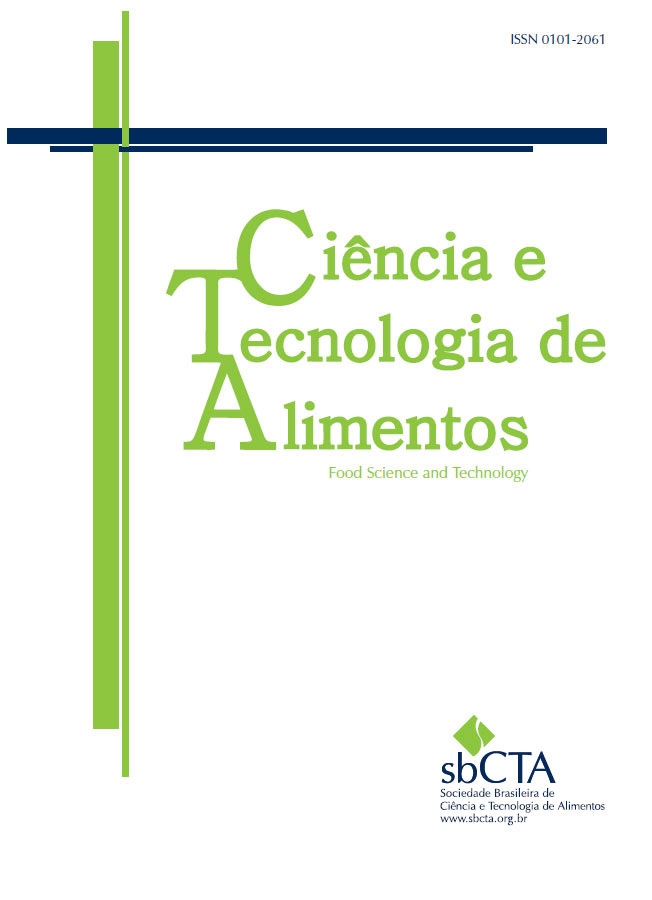Effect of roasted rice bran on the quality characteristics of biscuits developed with cassava starch
DOI:
https://doi.org/10.5327/fst.00380Palavras-chave:
rice bran, by-product, roasting, cassava starch, biscuits, nutritional valueResumo
This study aimed to evaluate the effect of roasted rice bran on the quality of cassava starch biscuits. The rice bran was submitted to heat treatment at 102.5 ± 2.5°C, with a roasting time that varied between 3 and 7 min. The optimal time for roasting was 5 min, with the bran having the characteristics of moisture (wet basis): 1.52% ± 0.20%, acidity: 0.24% ± 0.01% and lipids: 20.39% ± 0.18%. Four biscuit formulations were produced with 5, 10, 15, and 20% of roasted rice bran and a standard formulation (100% wheat flour). The nutritional value and sensory analysis of the biscuits were analyzed. The shelf life was tested for 60 days, at 30 ± 2°C, spaced 20 days apart for each measurement. The biscuit with rice bran roasted up to 15% proved to be acceptable from a nutritional value (ash: 2.54% ± 0.09%, proteins: 9.28% ± 0.19%, lipids: 20.78% ± 0.15%, fibers: 2.94% ± 0.03% and caloric value: 468.183 ± 0.57 kcal), water activity: 0.357% ± 0.028% and obtained an acceptance rate above 80%. The new biscuits produced were within acceptable quality standards for human consumption and it was concluded that roasted rice bran can be used as an ingredient in the production of biscuits with high nutritional and sensory quality.
Downloads
Referências
Abbas, M. (2017). (In) segurança alimentar e território em Moçambique: discursos políticos e práticas. Revista Núcleo de Estudos, Pesquisas e Projetos de Reforma Agrária, 38(20), 106-131. https://doi.org/10.47946/rnera.v0i38.5297
Bodie, A. R., Micciche, A. C., Atungulu, G. G., Rothrock, M. J., & Ricke, S. C. (2019). Current trends of rice milling byproducts for agricultural applications and alternative food production systems. Frontiers in Sustainable Food Systems, 3, 00047. https://doi.org/10.3389/fsufs.2019.00047
Bunde, M. C., Osundahunsi, F. O., & Akinoso, R. (2010). Supplementation of biscuit using rice bran and soybean flour. African Journal of Food, Agriculture, Nutrition and Development, 10(9), 4047-4059. https://doi.org/10.4314/ajfand.v10i9.62887
Brasil (1978). Agência Nacional de Vigilância Sanitária. Resolução CNNPA nº 12. Retrieved from https://bvsms.saude.gov.br/bvs/saudelegis/cnnpa/1978/res0012_30_03_1978.html
Champagne, E. T., Hron, R. J., & Abraham, G. (1992). Utilizing ethanol to produce stabilized brown rice products. Journal of the American Oil Chemists Society, 69(3), 205-208. https://doi.org/10.1007/BF02635887
Delahaye, E. P., Jiménez, P., & Pérez, E. (2005). Effect of enrichment with high content dietary fiber stabilized rice bran flour on chemical and functional properties of storage frozen pizzas. Journal of Food Engineering, 68(1), 1-7. https://doi.org/10.1016/j.jfoodeng.2004.05.048
Doporto, M. C., Sacco, F., Viña, S. Z. &, García, M. A. (2017). Quality and technological properties of gluten-free biscuits made with Pachyrhizus ahipa flour as a novel ingredient. Food and Nutrition Sciences, 8(1), 70-83. https://doi.org/10.4236/fns.2017.81005
Elgammal, R. E., Rabie, M. A., El Bana, M. A., & Saleh, M. E. N. (2018). Processing cookies from defatted thermal stabilized black rice bran. Journal of Food and Dairy Sciences, 3(3), 1-5. https://doi.org/10.21608/jfds.2018.77744
Food and Agriculture Organization (FAO) & World Health Organization (WHO )(1973). Energy and protein requirements: report of a joint FAO/WHO ad hoc expert committee. FAO & WHO.
Feddern, V., Durante, V. V. O., Miranda, M. Z., & Mellado, M. M. S. (2011). Physical and sensory evaluation of wheat and rice bran cookies. Brazilian Journal of Food Technology, 14(4), 267-274. https://doi.org/10.4260/BJFT2011140400032
Instituto Adolfo Lutz (2008). Métodos físico-químicos para análise de alimentos (4ª ed.). Instituto Adolfo Lutz.
Lacerda, D. B. C. L., Soares, M. S., Bassinello, P. Z., Castro, M. V. L., Silva-Lobo, V. L., Campos, M. R. H., & Siqueira, B. S. (2010). Qualidade de farelos de arroz cru, extrusado e parboilizado. Pesquisa Agropecuária Tropical, 40(4), 521-530. https://doi.org/10.1590/S1983-40632010000400004
Mariani, M., Oliveira, V. R., Faccin, R., Rios, A. O., & Venzke J. G. (2015). Elaboration and evaluation of gluten-free cookies made with rice bran and rice and soy fours. Brazilian Journal of Food Technology, 18(1), 70-78. https://doi.org/10.1590/1981-6723.6514
Mishra, N. (2017). Utilization of waste defatted rice bran in formulation of functional cookies and its effect on physiochemical characteristic of cookies. International Journal of Advanced Science and Research, 2(5), 64-68.
Mishra, N., & Chandra, R. (2012). Development of functional biscuit from soy flour and rice bran. International Journal of Agricultural and Food Science, 2(1), 14-20.
Oliveira, D. I., Kolakowski, A. P., Simões, D. R. S., Los, P. R., & Demiate, I. M. (2017). Biscoitos tipo cookie sem glúten formulados com farelo de feijão, farinha de arroz e amido de mandioca. Revista Brasileira de Tecnologia Agroindustrial, 11(2), 2502-2522. https://doi.org/10.3895/rbta.v11n2.5752
Ramezanzadeh, F. M., Rao, R. M., Prinyawiwatkul, W., Marshall, W. E., & Windhauser M. (2000). Effects of microwave heat, packaging, and storage temperature on fatty acid and proximate compositions in rice bran. Journal of Agricultural and Food Chemistry, 48(2), 464-467. https://doi.org/10.1021/jf9909609
Reid, D. S., & Fennema, O. R. (2008). Water and ice. In S. Damodaran, K. Parkin & O. R. Fennema (Eds.). Fennema's Food Chemistry (pp. 17-82). CRC Press.
Sapwarobol, S., Saphyakhajorn, W., & Astina, J. (2021). Biological functions and activities of rice bran as a functional ingredient: a review. Nutrition and Metabolic Insights, 14, 1-11. https://doi.org/10.1177/11786388211058559
Sharma, H. R., Chauhan, G. S., & Agrawal, K. (2004). Physico-chemical characteristics of rice bran processed by dry heating and extrusion cooking. International Journal of Food Properties, 7(3), 636-641. https://doi.org/10.1081/JFP-200033047
Soares, M. S., Bassinello, P. Z., Caliari, M., Gebin, P. F. C., Junqueira, T. L., Gomes, V. A., & Lacerda, D. B. C. L. (2009). Qualidade de pães com farelo de arroz torrado. Ciência e Tecnologia de Alimentos, 29(3), 636-641. https://doi.org/10.1590/S0101-20612009000300028
Tripathi, B., & Tripathi, R. (2018). Effect of wheat bran incorporation on physicochemical properties of sweet and salty biscuits. International Journal of Agricultural, 8(3), 119-126.
Xhabiri, G., Sinani, V., & Hoxha, I. (2014). The impact of the wheat bran on the quality of the biscuits and their nutritional value. Journal of the Association-Institute for English Language and American Studies, 3(3), 64-70.
Younas, A., Bhatti, M. S., Ahmed, A., & Randhawa, M. A. (2011). Effect of rice bran supplementation on cookie baking quality. Pakistan Journal of Agricultural Sciences, 48(2), 129-134.



